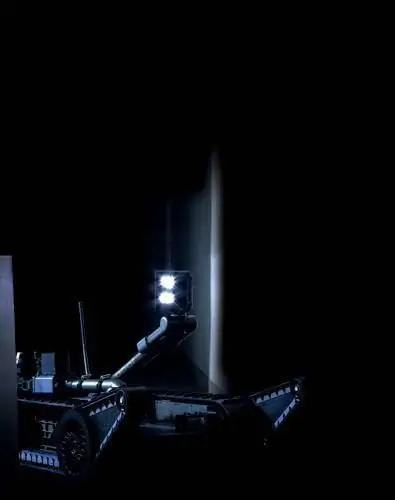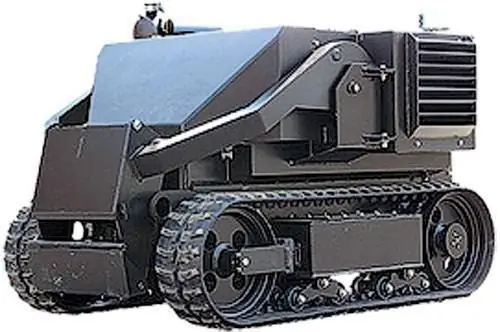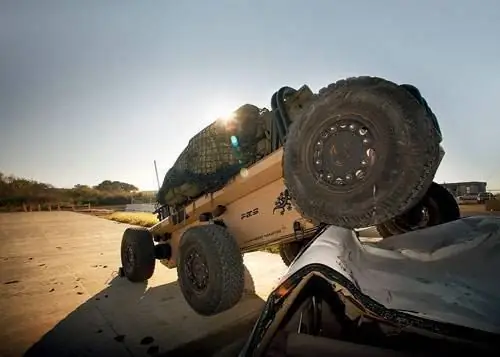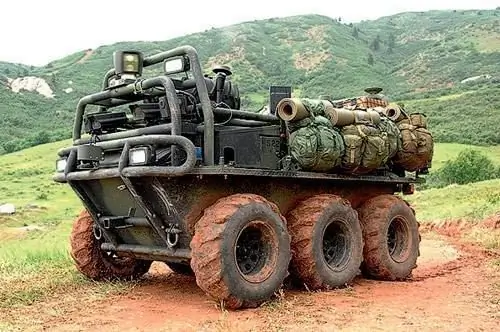- Author Matthew Elmers [email protected].
- Public 2023-12-16 21:49.
- Last modified 2025-01-24 09:17.
The successful combat work of unmanned aircraft became a prologue to further robotization of military equipment. Now is the time to descend from heaven to sinful earth.
In early September 2010, the Pentagon's special research unit RDECOM announced an open tender for the development and subsequent production of a ground-based unmanned transport vehicle. According to document number W91CRB-10-R-0098, the military is ready to conclude a fat contract for the supply of equipment with any company that can create a trouble-free mechanical donkey for combat units, capable of dragging weapons, ammunition, water, food and even the wounded after soldiers. The device should be no longer than 4m, have a carrying capacity of at least 0.54 tons, a minimum power reserve of 10 hours and a maximum speed of at least 6 km / h.
If these conditions cannot be called tough, then the requirements for the brains of the pack machine are much more serious. The main one is the complete autonomy of control based on the processing of data from a hybrid optical laser locating system, a GPS system and digital terrain maps. Mandatory requirements also include the availability of a manual remote control by means of a compact remote control that fits in the pocket of a standard army vest-unloading, and equipping the car with all-round television cameras with night vision function. And no tricks like radio beacons built into equipment or sewn into uniforms - the transporter should not be connected to the fighters with an electronic leash. In addition, the military wants to use the drone as a field generator or launcher for engines of military equipment.


Destroyer
This tender has been awaited for a long time, especially since the portfolios of dozens of startups and respectable corporations are jam-packed with promising projects. In 2004, the Pentagon's Defense Advanced Research Agency, DARPA, invited scientists from the NREC National Robotics Center at Carnegie Mellon University to develop a prototype of a universal unmanned combat vehicle for extreme terrain. And for good reason - by that time, the NREC team already had a six-wheeled Spinner, an experimental device that impressed the military with its off-road capabilities during tests at the proving ground in Arizona in 2003. Quite primitive in intelligence, the Spinner made a successful 150-kilometer dash down the mountain route, in which even an unkillable Hummvee would have lost wheels, axles and gearbox. It was this machine, created in cooperation with Boeing, Timoney Technology and UQM Technologies, that DARPA customers recommended to take as a source. NREC had to modify the power plant, strengthen the suspension, lighten the chassis and, of course, implant suitable brains for the future warrior.
The project, called Crusher, lasted four years and ended, according to Stephen Welby, curator of NREC from DARPA, an absolute victory. Not only has the Crusher become a third lighter than its progenitor, it surpassed it in all respects, including cross-country ability. In February 2008, public tests of two copies of the drone were carried out in the El Paso desert near the Fort Bliss military base. According to the testimony of the journalists invited to the training ground, what he saw could be compared with a Hollywood thriller. Seven-ton Rambo of aluminum, titanium and steel, like bulldozers, ironed everything in their path. The drones confidently overcame 45-degree mountain slopes, climbed over meter-high concrete pillboxes, flattened cars that fell under their feet, forced their way through rocky plateaus and dived into anti-tank ditches.
More than a hundred kilometers along the eerie off-road of El Paso, the cars passed at an average speed of over 10 km / h. And all this in a completely autonomous mode - the manual remote control was used only to demonstrate the potential of the concept. Tony Teter, a DARPA executive famous for his impenetrable composure, broke into a smile and called the Crusher a masterpiece of robotics. True, he immediately added that they would not take it into service - the next, even more advanced version of the machine would wear shoulder straps.

Six-wheeled tank
The virtual dissection of the Crusher demonstrates a rigid spatial skeleton of aluminum tubes of various cross-sections, connected by titanium nodal elements covered with a thick steel sheet. Each of the six wheels of the projectile has an independent link suspension with shock absorbers of variable stiffness. If necessary, the machine can completely sit on the bottom or rise above the ground by 77 cm. Electronics adapts the characteristics of the shock absorbers to driving conditions in a split second. Thanks to this, the Crusher successfully storms vertical ledges of 1, 2 m and easily swallows landings after flying over two-meter ditches.
To match the suspension and the power plant. It is hybrid: the wheel hubs are equipped with 47-horsepower DC electric motors weighing 41 kg each. The instantaneous thrust of such a motor measuring only 25x28 cm is 450 Nm. The voltage is supplied to them from a lithium-ion battery with a capacity of 18 kWh, which, in turn, is constantly charged by an on-board generator rotated by a 1.9 TDI turbodiesel from the serial Volkswagen Jetta. If the situation calls for maximum stealth from the Crusher, then for several miles the battery can completely silently move 7 tons of metal without a diesel recharge. In the event of a malfunction or battery failure, the electronics disconnects it from the general circuit and the generator begins to supply voltage to the hub motors directly.
None of the wheels have a turning mechanism, however, the Crusher, like a tank or an infantry fighting vehicle, is capable of turning 360 degrees in place. Maneuvering is performed by changing the thrust or turning off the motors on one side. The electronic control unit in this machine replaces the clutches and final drives familiar to every driver-mechanic of a tank or BMP without any mechanical connections.
All this economy rests on a powerful steel plate that repels mine strikes in the bottom. The reliability of the design is unprecedented, not least due to the lack of crew. The drone does not need to protect people from overloading during explosions or shelling. Silicon brains that fit in a shoebox are much more difficult to disable than normal human brains.

Seven-ton toy
The "intelligence chief" in the Crusher project were electronic engineers Dan Taccione and Tony Stentz. When developing a control and monitoring system for the car, they used non-military things: an iPhone, an iPod, an Xbox 360 game controller and a regular civilian laptop. According to Taccione, the soldiers who participated in the testing of the system liked to steer the drone "on a lazy man" more with the help of familiar gadgets. From the iPhone display, monitoring of the power plant, diagnostics of on-board systems and the current software update were carried out, and through the Xbox 360, operators controlled a telescopic mast with a height of 5, 5 m, cameras and even firing at a conventional enemy from a mounted shooting module. The remote control range of the Crusher is almost 800 m.
But for combat work, the drone does not need a special unit of gamer soldiers, turning the steering wheels of electronic simulators in an underground bunker. It feels much better in full autonomy mode. During trials at Fort Bliss, the Crusher shocked observers with its ability to independently choose a route in extremely difficult terrain. For each situation, the machine selects several possible options for moving from the starting point to the final one at once.
While moving along a mountain slope, it "instinctively" is pressed to the surface, lowering the point of the center of mass. When performing reconnaissance missions, it instantly calculates the most successful position for observation. And most importantly, the Crusher can learn from his own "experience" and over time turns from an untrained beginner into a seasoned commando.
According to NREC Director John Beers, the Crusher on-board computer uses three channels of information for self-management: digital maps of the area, a picture from television cameras and data from five laser rangefinders located in the front and rear of the vehicle. The Crusher software is capable of recognizing the height, surmountability and even the material nature of obstacles within a radius of 70 m. A drone can detect a running hare for a kilometer, and a person for four.
The high-definition color image from the TV camera located on the mast is transmitted to external devices. Imagine - throwing such a scout at some hard-to-reach point with an excellent position for observation for a month or two and around the clock fixing everything that happens within a radius of several kilometers, without risking the lives of soldiers. The possible loss of a car will not become a tragedy - in a war it is like in a war, but the information obtained with its help can be invaluable. Although you can't take this with your bare hands - the drone will shoot back to the last cartridge in the tape, and finally self-destruct.

Racers with pedigree
The Crusher's possibilities are not limitless. He doesn't "see" much. For example, boulders in thickets of thick grass and other obstructions hidden by visual clutter. Further improvement of electronic senses depends on technological advances in the field of lasers, radars and telematics. The NREC team's four years of work on the Crusher have yielded many spin-offs, including the Oka-sized Gladiator, a six-wheeled unmanned reconnaissance vehicle and a tiny Dragon Runner robot designed for US Marine Corps special forces. These are all experimental machines designed to test technology, and the main goal, as Tony Teter said, is yet to come.
Immediately after DARPA and NREC representatives signed their final autographs on the Crusher Projects, a new three-year program, the Autonomous Platform Demonstrator (APD), was launched. APD is the native child of the retired Crusher, grown in a virtual test tube at the Carnegie Mellon Laboratory. At this stage, the Pentagon presented scientists with much more serious conditions. The key parameter of the future unmanned combat vehicle is the maximum speed within 80 km / h. For this, the modest Volkswagen diesel engine will be replaced with a more powerful turbocharged unit.

In autonomous mode, the car should confidently perform maneuvers when changing lanes on the highway. APD should be an excellent climber and climb slopes up to 30 degrees laterally (although his dad Crusher kept his balance even at forty-five). But the crawling of a meter vertical obstacle along the front is already a solved problem. The maximum length of the vehicle is 4570 mm, and the curb weight is 9.6 tons. The six drive wheels with integrated electric motors and independent suspension are likely to be able to swivel along the vertical axis by 38 degrees.
Two fully equipped drones should fit in the fuselage of the Hercules C-130 transporter. It was decided to shorten the telescopic mast with a sensor module to 4 m in order to maximize the camouflage of the vehicle. Moreover, the new navigation system, oriented on the terrain using military GPS channels with high accuracy, and effective radars and laser rangefinders should provide APD with sufficient autonomy.

The original design of the APD was approved by DARPA back in August 2008, and from the beginning of 2009 the finished vehicle was delivered to the army training ground in Aberdeen. The tests planned for the fall of this year, together with the regular infantry units, have not yet been reported in open sources. However, 95% of the conditions set by the APD, which has passed more than 3000 km in recent years, is already fulfilling today.






